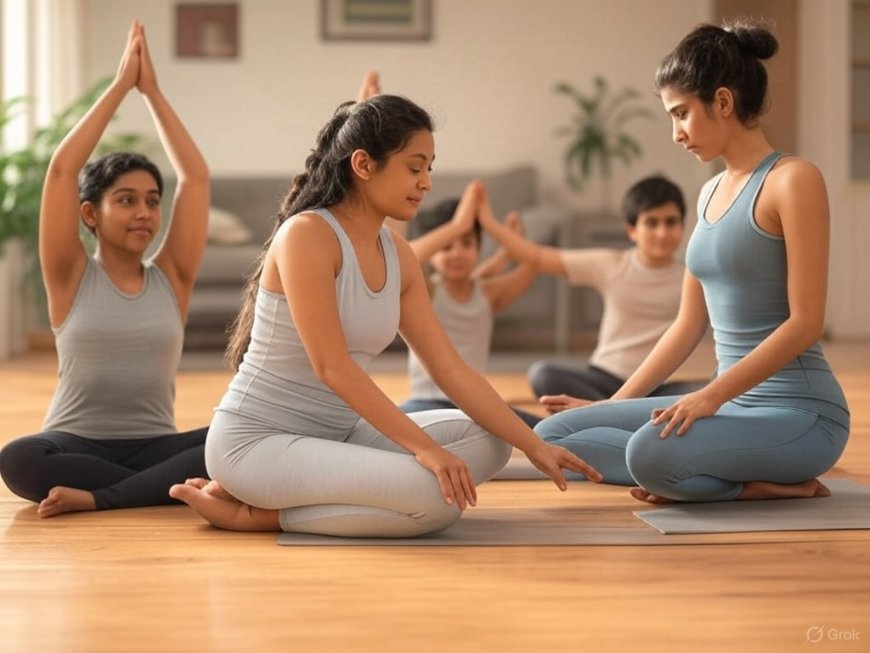The Mindful Home: How Indian Families Are Embracing Mental Wellness Together
Discover how Indian families are redefining mental health by embracing open conversations, therapy, and mindfulness. Learn about changing attitudes and holistic approaches to mental wellness in modern Indian households.

For decades, mental health remained a hushed topic within Indian households, cloaked in social stigma and misunderstanding. Emotional struggles were either brushed aside or misattributed to “weakness of character” or “overthinking.” But over the last few years, a quiet yet profound transformation has taken root—Indian families are beginning to talk, listen, and heal.
From prioritizing therapy to embracing mindfulness and emotional literacy, modern Indian homes are evolving into spaces of mental well-being and compassion. This article explores the changing attitudes, key drivers of the mental wellness movement in Indian families, and how generational gaps are finally being bridged.
The Shift: From Silence to Support
1. Breaking the Stigma
Thanks to increased awareness and accessible information, more families are willing to acknowledge mental health issues like anxiety, depression, burnout, and even disorders like OCD or bipolar disorder. Once taboo, these conversations are now gradually entering dinner table discussions, especially among younger generations.
Backlink: India’s Mental Health Landscape – Live Love Laugh Foundation
2. Role of Gen Z and Millennials
Younger members of Indian families are often the ones initiating mental health conversations. They seek therapy, practice mindfulness, and share resources, encouraging parents and elders to engage more empathetically.
According to India’s National Mental Health Survey, nearly 10% of adults in India suffer from common mental disorders, yet only a small percentage seek help. That number is slowly improving, especially in urban households.
Key Drivers of Change
1. Teletherapy and Mental Health Platforms
Platforms like BetterLYF, YourDOST, and MindPeers have made therapy confidential, affordable, and accessible. Families no longer need to navigate intimidating clinics or long wait times.
2. Corporate Wellness Initiatives
Working parents are exposed to mental health workshops, stress management webinars, and digital therapy as part of employee wellness programs. This exposure translates into greater acceptance at home.
Backlink: India Inc.’s Mental Health Push – People Matters
3. School and College Interventions
Educational institutions are introducing mental health curricula, peer support groups, and counselors, equipping students to understand and express emotional challenges. This influences their family environments too.
A Shift in Parenting Styles
Traditionally, Indian parenting leaned heavily on academic success, discipline, and resilience. Today’s parents are redefining these norms by emphasizing emotional intelligence, stress coping strategies, and open communication.
-
Mental check-ins with children are replacing harsh discipline
-
Mindful parenting workshops are becoming popular among urban moms and dads
-
Journaling, meditation, and gratitude practices are being introduced at home
Backlink: Mindful Parenting: A New Approach – ParentCircle
Mindfulness and Traditional Practices Reimagined
Ancient Indian traditions—once associated strictly with religious or spiritual contexts—are being adapted for everyday mental wellness. Families are now using:
-
Yoga and Pranayama for stress relief
-
Ayurvedic adaptogens like ashwagandha and brahmi for anxiety and sleep
-
Evening screen-free routines and guided meditation for better sleep hygiene
The fusion of modern psychology with ancient Indian wisdom has opened a new path for mental clarity and family bonding.
Backlink: Yoga and Mental Health – Ministry of AYUSH
Real Stories: How Families Are Changing
The Joshi Family from Pune
When their 17-year-old daughter experienced panic attacks, the Joshis sought help from a therapist and attended a family counseling session. "It helped us understand each other better, not just her condition," says Mr. Joshi.
The Kumars in Delhi
After the pandemic, the family began a ritual of evening gratitude journaling and weekly mental check-ins. "It brought us closer. We talk more freely now," says Meera Kumar, a school teacher.
Remaining Barriers and the Road Ahead
Despite the progress, mental health still faces cultural resistance in many regions. Common barriers include:
-
Fear of social judgment
-
Limited mental health professionals in rural areas
-
Over-medicalization or reliance solely on spiritual healing
-
Low awareness of preventive mental care
To overcome these, India needs policy reforms, more community-based interventions, and mental health education embedded in schools and colleges.
How Families Can Promote Mental Wellness
| Action | Benefit |
|---|---|
| Have regular open conversations | Builds emotional trust and reduces isolation |
| Attend family therapy if needed | Helps resolve generational misunderstandings |
| Set boundaries and digital detox hours | Reduces anxiety and improves sleep quality |
| Practice mindfulness together | Strengthens bonds and emotional regulation |
| Learn emotional vocabulary | Encourages better expression and empathy |
Final Thoughts
The mental wellness revolution in India isn’t being led by institutions alone—it’s being nurtured at home. Indian families are gradually transforming from units of silent suffering into communities of shared understanding. Whether it’s a parent learning to listen, a teen helping normalize therapy, or grandparents embracing yoga for emotional health, every small step is creating a ripple effect.
Mental wellness is no longer a private burden—it’s becoming a collective journey. And the Indian family, long seen as a bastion of cultural strength, is now rising as a pillar of emotional resilience too.
What's Your Reaction?
 Like
0
Like
0
 Dislike
0
Dislike
0
 Love
0
Love
0
 Funny
0
Funny
0
 Angry
0
Angry
0
 Sad
0
Sad
0
 Wow
0
Wow
0



















































